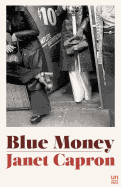
New York City writer Janet Capron offers a wild, bristling account of city life in the 1970s in her provocative semi-fictional memoir Blue Money.
According to her author's note, names from real life have been changed--except for Capron's--and some characters are fictionalized composites of real people. But the environment, the situations and the emotional turmoil are grittily true. Capron reconstructs an episodic narrative in which, as a young woman, she leaves a sheltered, privileged life to become a prostitute in a city seething with drugs and crime. Blue Money follows Capron through a jungle of johns, drug addiction and hallucinations, and the more tender thicket of young love, and the treachery of reckless men and the pain they bring. Many chapters contain explicit content, including a graphic scene of sexual violence that's not for the faint of heart.
Capron writes with the fearless, experiential drive of a Beat poet, though her images are more controlled and precise than the subject matter would suggest. There's an enormous amount of clarity here. For example, the author's self-described stint as a radical feminist produces sharp insights into the way patriarchy divides "good" women from "bad" women. "I would build an arch across this ancient fissure. I would free myself from all the hobbling generalizations," she writes. Capron skillfully digs into social hierarchies to find the city's hidden pulse. She finds plenty of seediness and self-destruction, but also, in the book's best moments, "the unexpected, electric weight of intimacy." --Scott Neuffer, freelance journalist, poet and fiction author

